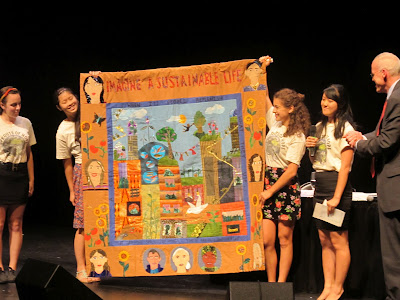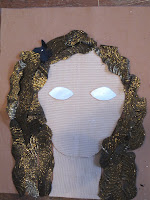Tea with Gloria Steinem
On Friday afternoon, April 20th, The Sprouts of Hope, had tea with Gloria Steinem at the New York City apartment where we were staying. This gathering happened because Jane O'Reilly, a longtime friend of Gloria's from their days working together as journalists on Ms. Magazine, wrote to her friend and asked her. Gloria said "Yes." Jane asked her because it had become apparent that the Sprouts had not learned about America's second wave of feminism, despite having been taught in middle school about the women who led the first wave of feminism during the suffrage movement. Yet, it is because of the efforts of Gloria and her feminist colleagues that girls growing up now experience an equality of opportunity that was unimaginable to her generation when they were this age in the 1950s.
By Maya
Having the opportunity to meet Gloria Steinem and Jane
O’Reilly was truly a wonderful experience.
 |
| Longtime friends: Gloria Steinem (left) and Jane O'Reilly |
Listening to them made me realize how far women
have come in the last half century and how far there is still to go. I was inspired by their writings and their life journeys, and by their ability to maintain humble and humorous
personalities. Gloria told us a story about helping women who'd been forced into sex trafficking by building an electric fence, and that story taught me a lot about why listening is the essential first step in helping anybody. I never would have thought keeping elephants out of maize fields
could be a solution to the sex trafficking of women.
In listening to these two women tell us about their lives, I learned much
about how to be a leader and work toward making effective change. Jane’s cover
story on the first issue of Ms. Magazine — about the housewife's predetermined role in society — intrigued me. I read her article, "The Housewife's Moment of Truth," before I met her.
 |
| Jane O'Reilly's Ms. Magazine article about housewives. It was this new magazine's first cover story when it was published in December 1971. |
Jane wrote about how little things that used to happen to housewives every day were one day transformed into moments when the women experienced a “click” that made them realize that their lives as women didn’t need to be the way they were.
Gloria suggested we read one of her essays, "If Men Could Menstruate," before we met her, and I was glad she did. It is not something I would have found on my own, and yet I enjoyed the perspective that her words gave us.
It has taken me some time for my brain to “click” and
realize that just a few weeks ago I sat in a four-story walk-up in New York City eating
crackers and Italian pastries with these two remarkable women.
By
Lilly
Meeting
with Ms. Steinem completely changed how I thought of women’s rights today. I
had previously assumed that we were past all the big leaps that had to be
taken. All around me, I see women in successful and powerful positions in
society with rights completely equal to those of men. However, she made me see
that we still have a ways to go. In other countries and even our own, sex trafficking is a huge problem. And women who work in all kinds of jobs still get paid lower wages than men. And even in our own community, it can be harder
for girls just to participate in sports.
All of this is not to say that Ms.
Steinem was in any way discouraging. She did raise my awareness about new
issues, but not without providing ideas and solutions. She was incredibly warm
and easy to hold a conversation with, not at all intimidating or superior. It
was really a wonderful and valuable experience to have as a girl in this
time.
 |
| From left to right, Lilly, Gloria, Kaya, Risa, Maya |
By Risa
When Ms. Steinem stepped out of the taxi, I was surprised by
her youthfulness, and by how relaxed and collected she seemed. I feel very honored
that she took the time to sit and talk with us, especially because she had just
come back from a trip overseas. I was inspired by how she approaches situations — with a
clear and open mind. She is a strong and opinionated woman; I am sure that when
she sets her mind to doing something, she does not stop until it’s been
achieved.
Yet, the message that will stay with me forever that took away from
our conversation is the importance of listening, especially to people who you think
might want your help. She is a great storyteller. In response to a question that Jane O'Reilly's granddaughter Elena asked her — about how Westerners often seem to arrive in foreign countries with an idea already in their heads of how they are going to help people they've never met — Gloria told us a great story about how the complex problem of women being trafficked for sex had been solved by something as simple as a fence. It wasn't a solution anyone would have thought of unless they talked and listened carefully about the situation that women in this village were experiencing. Turns out that the women couldn't plant and harvest their maize crop — and with it feed their families — unless they find a way to stop elephants from coming into their fields.
 |
| An electric fence is able to prevent elephants from going into areas where they will damage crops. |
The lesson I took away from this story is that only by listening to and talking with someone and taking time to understand a
situation completely is it possible to know how to help in ways that will be effective.
By Kaya
Gloria
Steinem told us about some of the ways she is working to stop the trafficking
of women and girls for sex. She described a trip to India she had just returned
from when
she talked with trafficked women.
 |
| Ruchira Gupta is president of Apen Aap and devotes her energies to ending the trafficking of women in India. |
Gloria explained to us that Americans
do not realize how women are forced into selling their bodies for sex; the
women are not doing this out of their own free will. Today millions of humans
throughout the world are being trafficked, including in the United States. Gloria
let us know the astonishing fact that the average age at which children are
first trafficked in the United States is 12 to 13, and they are eve younger
when it happens to them in India.
We sipped tea and munching on cheese & crackers and pastries we'd chosen at Ferrara's in Little Italy when we went there on Thursday night.
 |
| The pastries we had to choose from at Ferrara's in New York City's Little Italy. |
And we discussed with Gloria and her friend Jane O’Reilly our thoughts about feminism and the lives of girls and women today. It was an
inspirational to spend this time with Gloria Steinem whose life is such a terrific
example for us to emulate. Not only was Gloria full of stories and fascinating information,
but she is also delightfully funny—scattering jokes and good humor throughout our conversation!
I enjoyed
every second we spent with her, and I learned a lot about feminism in the past and today. All of what we talked about
made me think about how I interact with sexism I see happening in my life and
feminism in our society.
Unfortunately,
teenagers and children growing up now do not know much about Gloria Steinem,
and this is a shame. Everyone should know about her so they can be inspired by
how she has spent her lifetime dedicated to securing equal rights for women;
what she did many years ago is why I and so many other girls have the
opportunities we do today. She devoted her life to being an advocate for change,
and she has succeeded in many magnificent ways. I am so grateful I had this
amazing opportunity to spend time talking with this inspirational woman. Thank
you, Gloria!
 |
| From left to right, Elena, Melissa, Lilly, Gloria, Kaya, Risa and Maya. |



+copy.JPG)





















 Clara assembled the portraits we had made and showed up how they will look along the rim of the quilt. She added a thin blue boarder where we are planning to write some form of a story. We made portraits of inspiring environmentalists. Risa did one of Bill McKibben, Clara did one of Wangari Maathai, and I did one of Jane Goodall. All the portraits came out great, and will hopefully be easily recognizable.
Clara assembled the portraits we had made and showed up how they will look along the rim of the quilt. She added a thin blue boarder where we are planning to write some form of a story. We made portraits of inspiring environmentalists. Risa did one of Bill McKibben, Clara did one of Wangari Maathai, and I did one of Jane Goodall. All the portraits came out great, and will hopefully be easily recognizable.























